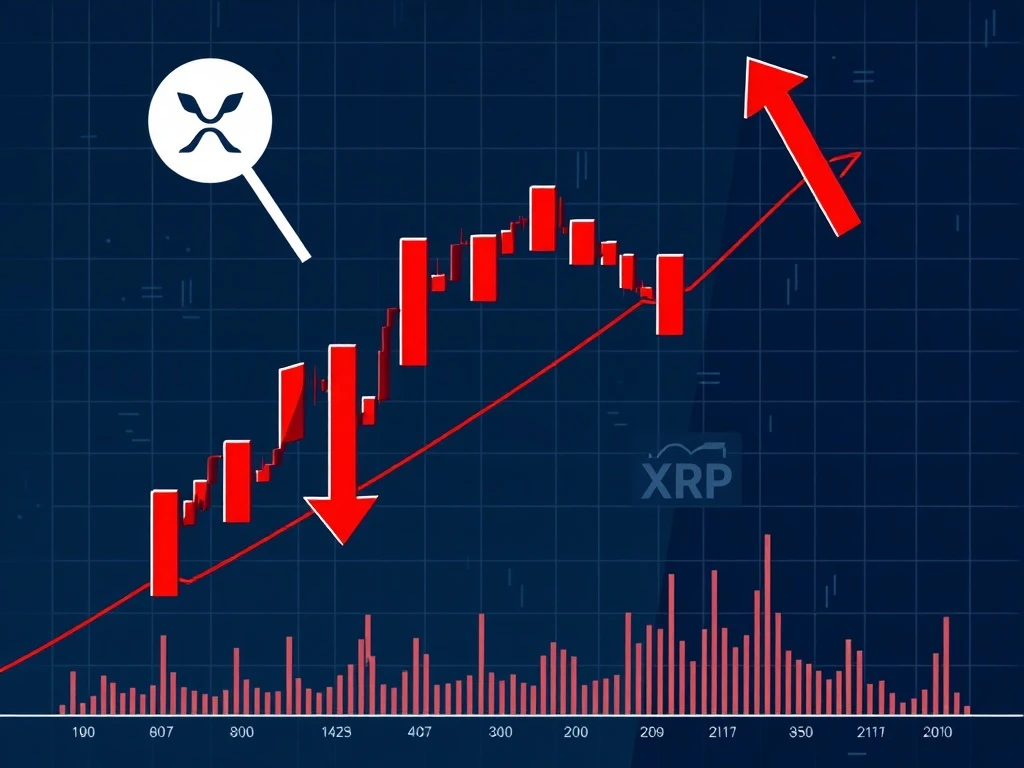XRP Price: 4 Alarming Reasons Why the Downtrend Could Intensify

Are you tracking the volatile world of cryptocurrencies? The current XRP price trajectory has caught the attention of many investors. Recent data highlights significant investor profit-taking. It also reveals compelling reasons why this altcoin’s value might continue to fall. Understanding these factors is crucial for anyone involved in the digital asset space. This article provides a comprehensive look at the forces driving the current XRP downtrend.
XRP Price: A Bearish Chart Pattern Emerges
XRP currently trades 23% below its multi-year peak of $3.66. A convergence of several data points signals a possible drop toward $2.40. Data from Crypto News Insights Markets Pro and TradingView shows XRP trading below a descending triangle. This pattern appeared in the daily time frame. A descending triangle is a bearish chart pattern. It features a flat, horizontal support line and a downward-sloping upper trendline. The price broke below the support line of this pattern at $2.95 on Tuesday. This action continued the downward trend. The measured target for this move is $2.40. Such a decline would represent an 18% drop from current levels.
XRP/USD daily chart. Source: Crypto News Insights/TradingViewAs Crypto News Insights reported, the altcoin needs to reclaim the $3 support level. This is necessary to avoid a deeper correction toward $2.24. The price reclaimed this level twice recently. These instances occurred in mid-July and early August. They preceded 25% and 15% rallies, respectively. Therefore, failure to reclaim this key level could signify further weakness for the XRP price.
XRP Analysis: Bearish Divergence in XRP/BTC Pair
The growing bearish divergence between the XRP/BTC pair and the Relative Strength Index (RSI) supports XRP’s bearishness. The daily chart below shows the XRP/BTC pair rising between July 10 and Aug. 18. During this period, it formed higher lows. However, its daily RSI descended to 43 from overbought conditions at 75 over the same time frame. This created lower lows, as shown in the chart below.
XRP/BTC daily chart. Source: Crypto News Insights/TradingViewA negative divergence between falling prices and a rising RSI often indicates weakness in the prevailing uptrend. This prompts traders to book profits at higher levels. Investor interest decreases as buyer exhaustion sets in. The chart also reveals that XRP/BTC sits above a key support zone. This zone is between 0.0000245 BTC and 0.0000250 BTC. The 200-day simple moving average embraces this area. A drop below this critical area could see the XRP/BTC pair continue its XRP downtrend. A further drop in the XRP price would fuel this decline.
Declining Network Activity Amplifies XRP Sell-Off
The XRP Ledger has experienced a significant drop in network activity. This decline is notable compared to Q1/2025 and the period between June and July. On-chain data from Glassnode reveals a sharp decrease in daily active addresses (DAAs). The network’s DAAs are now far below numbers seen in March and June. The ledger recorded a robust 608,000 DAAs on March 19. It also saw 577,134 on June 16. These figures reflected high user engagement and transaction activity. However, a dramatic slump occurred from the end of June through August. The chart below illustrates this decline.
XRP Daily Active Addresses. Source: GlassnodeWith only around 33,000 daily active addresses currently, user transactions have decreased significantly. This possibly signals reduced interest or a lack of confidence in XRP’s near-term outlook. Historically, declines in network activity typically signal upcoming price stagnation. Lower transaction volume reduces liquidity and buying momentum. Furthermore, the number of transactions has also decreased by 51%. It fell from 2.5 million in June to 1.25 million at the time of writing, according to CryptoQuant data. Transaction count and active addresses are widely used metrics. They estimate the number of users interacting with a network. They offer valuable insights into the network’s overall activity and user engagement. These serve as key indicators of blockchain adoption and interaction with the underlying token. Therefore, this significant drop in these on-chain indicators might drive XRP’s value lower. It sparks speculation that the token could sink deeper in the short term, impacting the overall XRP forecast.
Negative CVD Backs XRP’s Downside in the Crypto Market
Analyzing the 90-day spot taker cumulative volume delta (CVD) reveals intensifying sell-side activity. CVD measures the difference between buy and sell volume over a three-month period. Since July 28, selling pressure has dominated the order book. This began after the XRP/USD pair hit multi-year highs above $3.66 on July 18.
XRP spot taker CVD. Source: CryptoQuantThe negative CVD, represented by red bars in the chart above, indicates profit-taking among traders. This signals waning demand as sellers take control. If the CVD remains negative, sellers are not backing down. This could set the stage for another leg down, as seen in historical corrections. More than 91% of the XRP supply still remains in profit at current prices. Consequently, investors could continue locking in gains. This action adds to the headwinds faced by XRP in the broader crypto market. This persistent selling pressure further solidifies the bearish XRP forecast.
Conclusion: What Lies Ahead for XRP?
The confluence of these four factors paints a challenging picture for XRP. The descending triangle pattern suggests a clear technical breakdown. The XRP/BTC bearish divergence indicates underlying weakness against Bitcoin. Furthermore, declining network activity points to reduced user engagement and interest. Finally, the negative CVD confirms strong selling pressure from profit-takers. Investors should monitor these indicators closely. The current data strongly suggests that the XRP price could face continued downward pressure in the near term. This article does not contain investment advice or recommendations. Every investment and trading move involves risk. Readers should conduct their own research when making a decision.








